1998 GMC SIERRA cruise control
[x] Cancel search: cruise controlPage 119 of 452
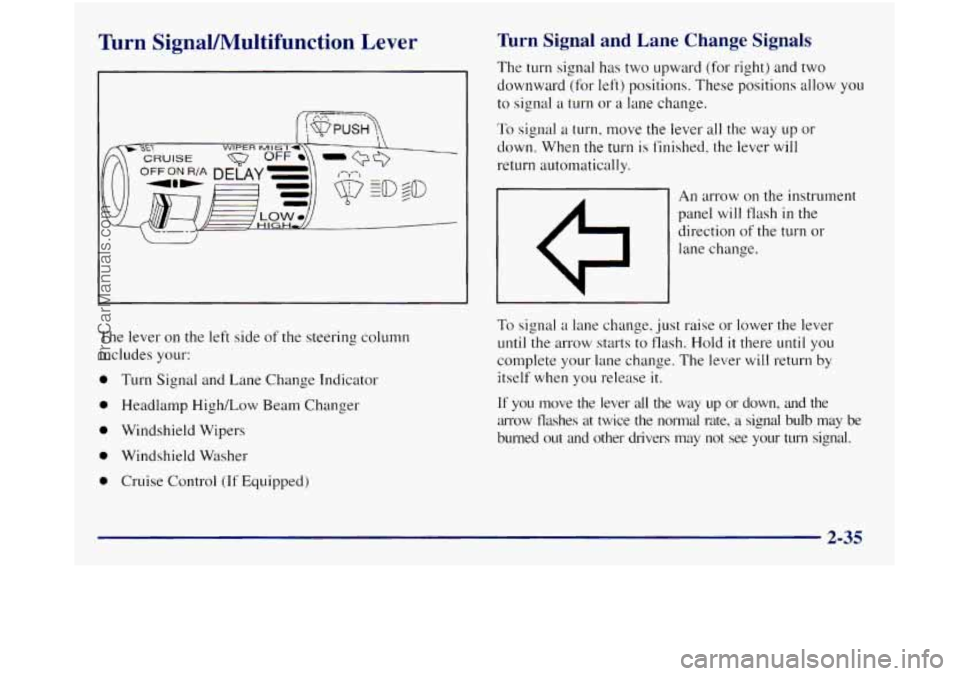
Turn SignaVIWultifunction Lever Turn Signal and Lane Change Signals
The turn signal has two upward (for right) and two
downward (for left) positions. These positions allow you
to signal
a turn or a lane change.
To signal a turn, move the lever all the way up or
down. When
the turn is finished, the lever will
return automatically.
An arrow on the instrument
panel will flash
in the
direction
of the turn or
lane change.
The lever on the left side
of the steering column
includes your:
0 Turn Signal and Lane Change Indicator
0 Headlamp High/Low Beam Changer
0 Windshield Wipers
0 Windshield Washer
0 Cruise Control (If Equipped)
To signal a lane change, just raise or lower the lever
until the arrow starts to flash. Hold it there
until you
complete your lane change. The lever will return by
itself when you release it.
If you move the lever all the way up or down, and the
arrow flashes at twice the normal rate,
a signal bulb may be
burned out and other drivers may not see your
turn signal.
2-35
ProCarManuals.com
Page 122 of 452
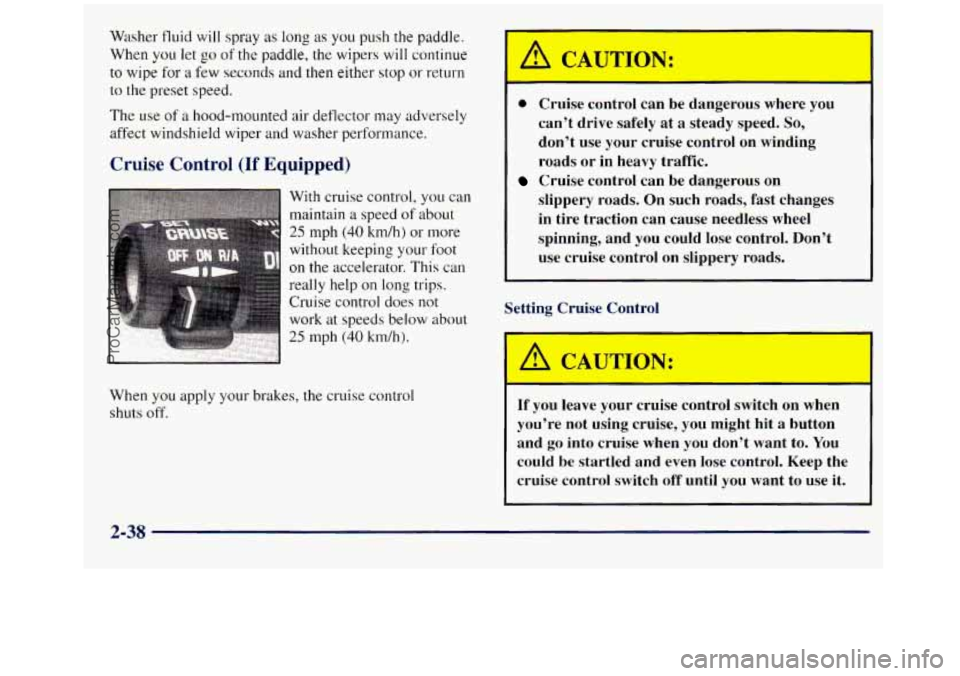
Washer fluid will spray as long as you push the paddle.
When you let
go of the paddle, the wipers will continue
to wipe for
a few seconds and then e.ither stop or return
to the preset speed.
The use of a hood-mounted air deflector may adversely
affect windshield wiper and washer performance.
Cruise Control (If Equipped)
really help on long trips.
Cruise control does not
work at speeds below about
, .. .. .. . , . :.!r+.l .. 25 mph (40 km/h).
When
you apply your brakes, the cruise control
shuts
off.
C * ‘JTIOT ;
0 Cruise control can be dangerous where you
can’t drive safely at a steady speed. So,
don’t use your cruise control on winding
roads or in heavy traffic.
slippery roads. On such roads, fast changes in tire traction can cause needless wheel
spinning, and you could lose control. Don’t
use cruise control on slippery roads.
Cruise control can be dangerous on
Setting Cruise Control
If you leave your cruise control switch on W,AI
you’re not using cruise, you might hit a button
and
go into cruise when you don’t want to. You
could
be startled and even lose control. Keep the
cruise control switch off until
you want to use it.
2-38
ProCarManuals.com
Page 123 of 452
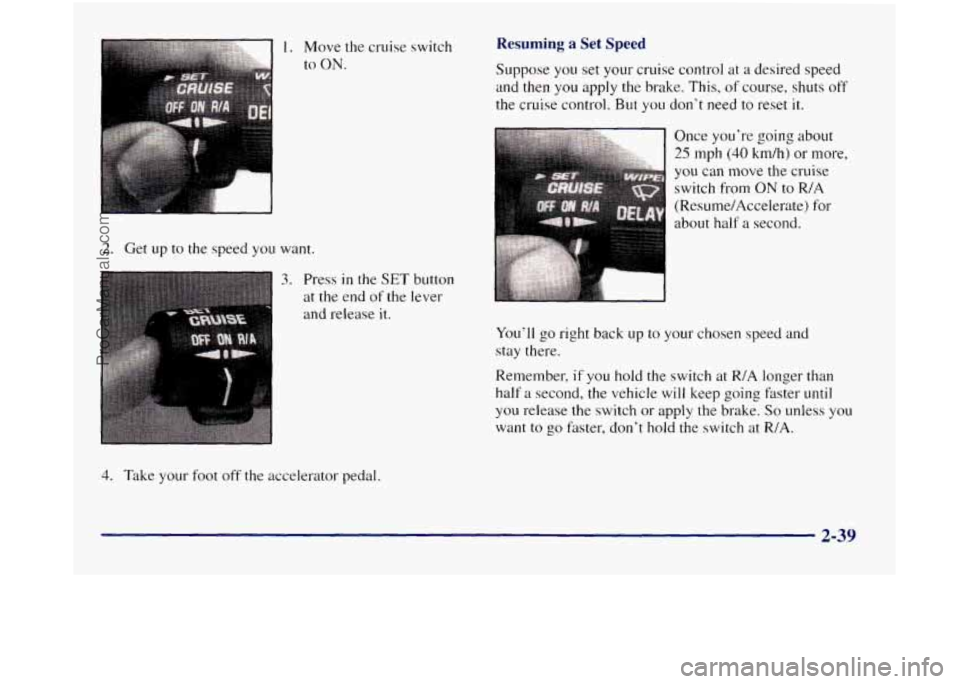
2. Get up to the speed you want.
3. Press in the SET button
at the end
of the lever
and release
it.
4. Take your foot off the accelerator pedal.
Resuming a Set Speed
Suppose you set your cruise control at a desired speed
and then you apply the brake. This, of course,
shuts off
the cruise control.
But yo11 don’t need to reset it.
.. Once you’re going about
25 mph (40 kdh) or more,
you can move the cruise
switch from
ON to RIA
(Resume/Accelerate) for
about
half a second.
You’ll go right back up to your chosen speed and
stay there.
Remember,
if you hold the switch at R/A longer than
half
a second, the vehicle will keep going fister until
you release the switch or apply the brake. So unless you
want
to go fdster, don’t hold the switch at R/A.
2-39
ProCarManuals.com
Page 124 of 452
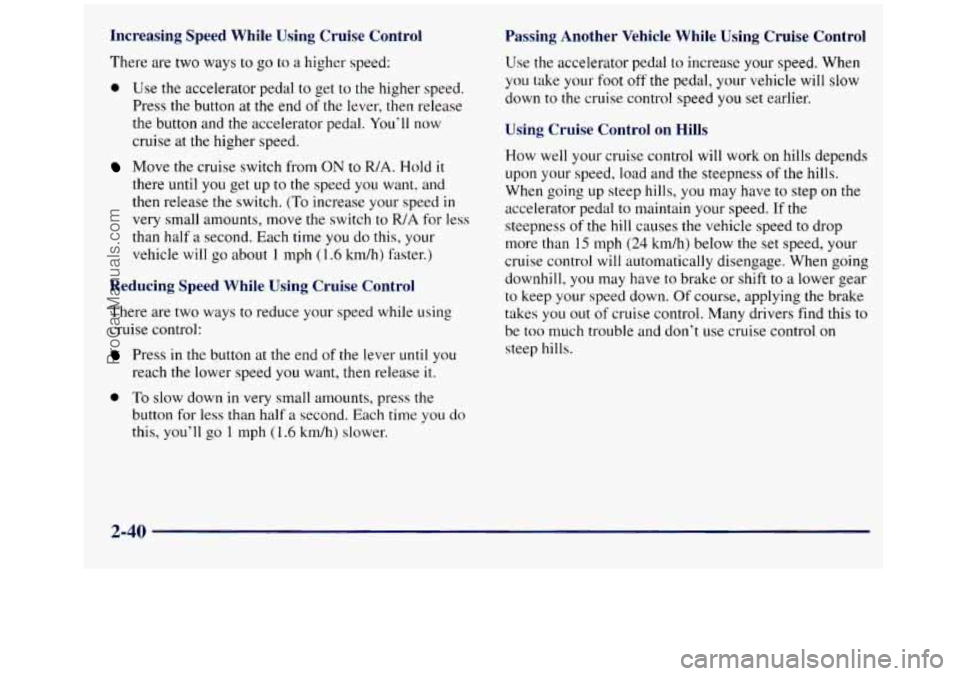
Increasing Speed While Using Cruise Control
There are two ways to go to a higher speed:
0 Use the accelerator pedal to get to the higher speed.
Press
the button at the end of the lever, then release
the button and the accelerator pedal. You’ll now
cruise at
the higher speed.
Move the cruise switch from ON to R/A. Hold it
there until
you get up to the speed you want, and
then release the switch.
(To increase your speed in
very small amounts, move the switch to R/A for less
than half
a second. Each time you do this, your
vehicle will
go about 1 mph (1.6 km/h) faster.)
Reducing Speed While Using Cruise Control
There are two ways to reduce your speed while using
cruise control:
Press in the button at the end of the lever until you
reach the lower speed
you want, then release it.
0 To slow down in very small amounts, press the
button for less than half a second. Each time you
do
this, you’ll go 1 mph (1.6 km/h) slower.
Passing Another Vehicle While Using Cruise Control
Use the accelerator pedal to increase your speed. When
you take your
foot off the pedal, your vehicle will slow
down to the cruise control speed
you set earlier.
Using Cruise Control on Hills
How well your cruise control will work on hills depends
upon your speed, load and the steepness of
the hills.
When going up steep hills, you may have to step on the
accelerator pedal to maintain your speed. If the
steepness
of the hill causes the vehicle speed to drop
more than
15 mph (24 km/h) below the set speed, your
cruise control will automatically disengage. When going
downhill, you may have
t.o brake or shift to a lower gear
to keep your speed down. Of course, applying the brake
takes
you out of cruise control. Many drivers find this to
be
too much trouble and don’t use cruise control on
steep hills.
2-40
ProCarManuals.com
Page 125 of 452
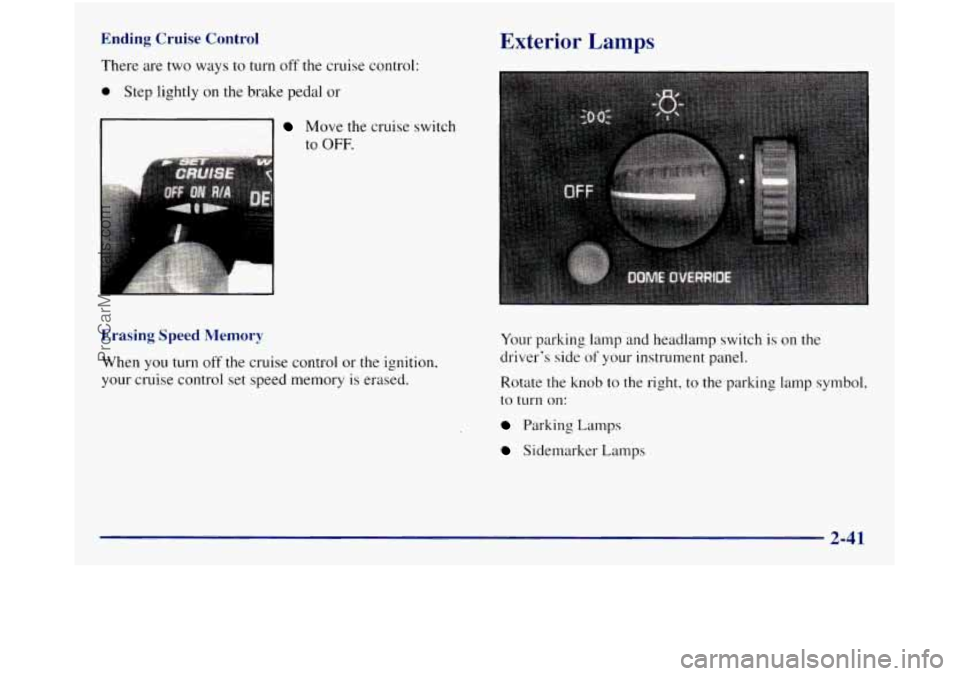
Ending Cruise Control
There are two ways to turn off the cruise control:
0 Step lightly on the brake pedal or
Move the cruise switch
to
OFF.
Erasing Speed Memory
When you turn off the cruise control or the ignition,
your cruise control set speed memory is erased.
Exterior Lamps
Your parking lamp and headlamp switch is on the
driver's side
of your instrument panel.
Rotate the knob to the right, to the parking lamp symbol.
to
turn on:
Parking Lamps
Sidemarker Lamps
2-41
ProCarManuals.com
Page 363 of 452

FuseKircuit Breaker
3
4
Usage
Courtesy Lamps, Cargo Lamp,
Glove Box Lamp, Dome/Reading
Lamps, Vanity Mirrors,
Power Mirrors
Instrument Cluster, DRL Relay,
Lamp Switch, Keyless Entry,
Low Coolant Module, Illuminated Entry Module,
DRAC (Diesel Engine)
Not Used
Cruise Control
Auxiliary Power Outlet
Crank
License Lamp, Parking Lamps,
Taillamps,
Roof Marker Lamps,
Tailgate Lamps, Front
Sidemarkers, Fog Lamp Relay,
Door Switch Illumination,
Fender Lamps, Headlamp Switch Illumination
FuseKircuit
Breaker
10
11
12
13
14
15
I6
17
18
19
Usage
Air Bag System
Wiper Motor, Washer Pump
A/C,
A/C Blower,
High Blower Relay
Power
Amp, Cigarette Lighter,
Door Lock Relay,
Power Lumbar Seat
4WD Indicator, Cluster, Comfort
Controls, Instrument Switches,
Radio Illumination,
Chime Module
DRL Relay,
Fog Lamp Relay
Front and Rear Turn Signals,
Back-up Lamps, BTSl Solenoid
Radio (Ignition)
4WAL/VCM, ABS. Cruise Control
Radio (Batterv)
6-73
ProCarManuals.com
Page 414 of 452
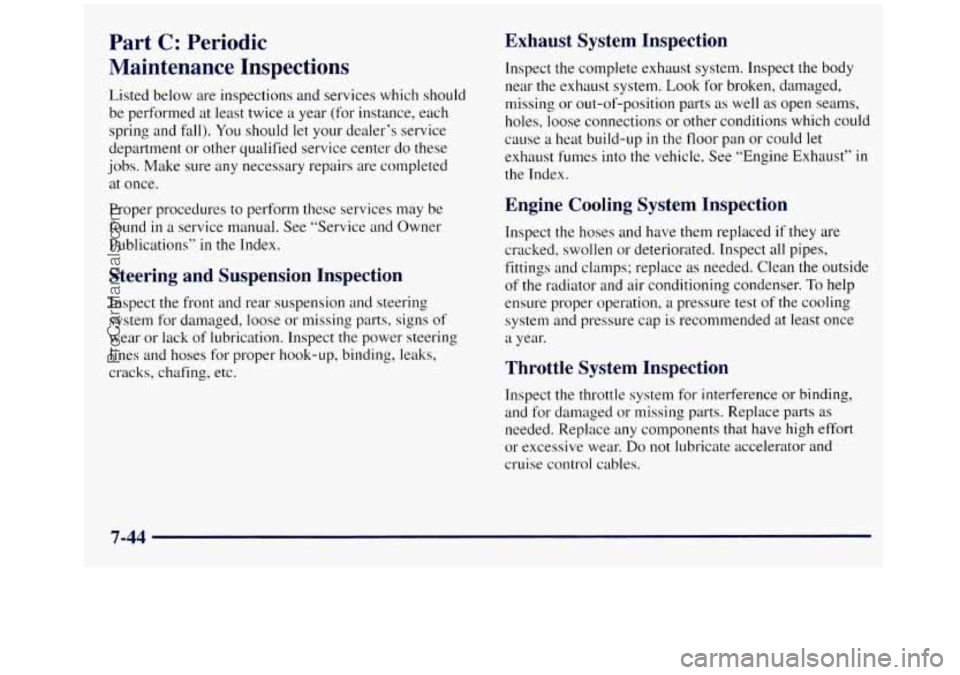
Part C: Periodic
Maintenance Inspections
Listed below are inspections and services which should
be performed at least twice a year (for instance, each
spring and fall).
You should let your dealer’s service
department or other qualified service center
do these
jobs. Make sure any necessary repairs are completed
at once..
Proper procedures to perform these services may be
found in a service manual. See ”Service and Owner
Publications”
in the Index.
Steering and Suspension Inspection
Inspect the front and rear suspension and steering
system for damaged, loose or missing parts, signs of
wear or lack of lubrication. Inspect
the power steering
lines and hoses for proper hook-up, binding, leaks,
cracks, chafing, etc.
Exhaust System Inspection
Inspect the complete exhaust system. Inspect the body
near the exhaust system.
Look for broken, damaged,
missing or out-of-position parts as well as open seams,
holes, loose connections or other conditions which could
cause
a heat build-up in the floor pan or could let
exhaust fumes into the vehicle. See ”Engine Exhaust” in
the Index.
Engine Cooling System Inspection
Inspect the hoses and have them replaced if they are
cracked, swollen or deteriorated. Inspect all pipes,
fittings and clamps; replace as needed. Clean the outside
of the radiator and air conditioning condenser. To help
ensure proper operation, a pressure test of the cooling
system and pressure cap is recommended at least once
a year.
Throttle System Inspection
Inspect the throttle system for interference or binding,
and for damaged or missing parts. Replace parts as
needed. Replace any components that have high effort
or excessive wear.
Do not lubricate accelerator and
cruise control cables.
7-44
ProCarManuals.com
Page 437 of 452
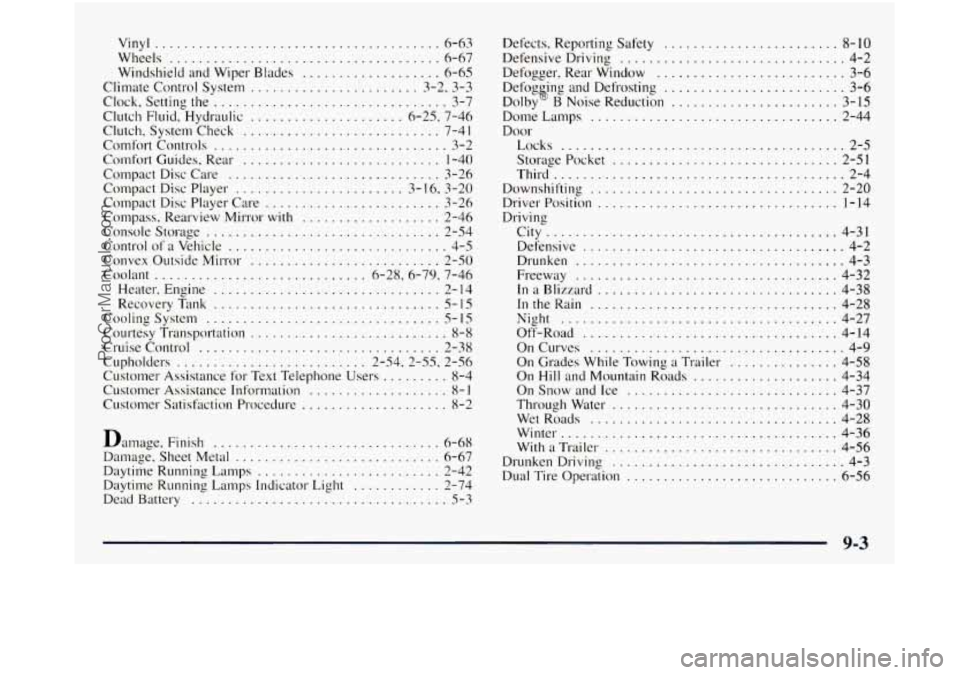
Vinyl ....................................... 6-63
Wheels
..................................... 6-67
Windshield and Wiper Blades
................... 6-65
Clock. Setting the ................................ 3-7
Clutch Fluid. Hydraulic
..................... 6-25. 7-46
Clutch. System Check
........................... 7-41
Comfort Controls
................................ 3-2
Comfort Guides. Rear
........................... 1-40
Compact Disc Care
............................. 3-26
Compact Disc Player
.......................
3-16 . 3-20
Compact Disc Player Care
........................ 3-26
Compass. Rearview Mirror
with ................... 2-46
Console Storage
................................ 2-54
Control
of a Vehicle .............................. 4-5
Convex Outside Mirror .......................... 2-SO
Coolant ............................. 6-28.6-79.7-46
Heater
. Engine ............................... 2- 14
Recovery Tank ............................... 5- I5
Cooling System ................................ 5- IS
Courtesy Transportation ........................... 8-8
Cruise Control
................................. 2-38
Cupholders
.......................... 2.54.2.55. 2-56
Customer Assistance Information ................... 8- I
Customer Satisfaction Procedure .................... 8-2
Climate Control System ....................... 3.2 . 3-3
Customer Assistance for Text Telephone Users
......... 8-4
Damage. Finish
............................... 6-68
Darnage. Sheet Metal
............................ 6-67
Daytime Running Lamps
......................... 2-42
Daytime Running Lamps Indicator Lighl
............ 2-74
Dead Battery
................................... 5-3
Defects. Reporting Safety ........................ 8- 10
Defensive Driving ............................... 4-2
Defogger. Rear Window .......................... 3-6
Defoggng
and Defrosting ......................... 3-6
Dolby B Noise Reduction
....................... 3-15
Dome Lamps
.................................. 2-44
DO0
I.
Locks ....................................... 2-5
Storage Pocket ............................... 2-51
Third
........................................ 2-4
Downshifting
.................................. 2-20
Driver Position ................................. 1-14
Driving City
........................................ 4-31
Defensive
.................................... 4-2
Drunken
..................................... 4-3
Freeway
.................................... 4-32
In a Blizzard ................................. 4-38
In the Rain .................................. 4-28
Night
...................................... 4-27
Off-Road
................................... 4-14
On Curves
................................... 4-9
On Grades While Towing a Trailer ............... 4-58
On Hill and Mountain Roads .................... 4-34
On Snow and Ice
............................. 4-37
Through Water
............................... 4-30
Wet Roads
.................................. 4-28
Winte
l- ...................................... 4-36
With
a Trailer ................................ 4-56
Drunken Driving
................................ 4-3
Dual Tire Operation
............................. 6-56
9-3
ProCarManuals.com